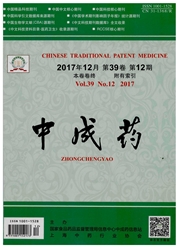

 中文摘要:
中文摘要:
目的:考察20(S)-原人参二醇(20(S)-PPD)复合微球的体外长期和加速释药规律。方法:采用溶剂乳化挥发法制备药物复合微球,采用残余法测定药物在复合微球中的体外长期和加速释放度,评价两种体外释放之间的相关性,对体外长期释放模型进行拟合,研究微球体外长期释药机制。结果:复合微球的体外长期释放数据显示,药物无明显突释,释放至33d时,累积释放率达50.87%,具有明显缓释效果;体外长期释放曲线符合Higuchi方程,表明其体外长期释放以扩散机制为主;复合微球在37℃体外长期释放的累积释放率(Q37,%)与50℃下加速释放的累积释放率(Q50,%)的相关性拟合方程为ln(100-Q50)=2.1378ln(100-Q37)-5.1832,(r=0.9744),体外长期和加速释放的相关性良好。结论:20(S)-PPD复合微球的体外长期释放表明,微球具有良好的缓释效果,可用体外加速释放评价法来指导微球的后续处方与工艺优化,为研发20(S)-PPD微球制剂提供了参考依据。
 英文摘要:
英文摘要:
Objective:To study the drug release in both long-term and accelerated situation of 20(S)-Pro-topanaxadiol complex microspheres.Methods:Prepared the microspheres by the emulsion solvent evaporation method.Residual method was used to determine the degree of the drug release of 20(S)-PPD both in long-term and accelerated situation.Evaluated the correlation between the two kinds of in vitro drug release,fit the model of long-term drug release,and studied the mechanism for the long-term drug release in vitro. Results:The long-term drug release data showed that there was no obvious burst release,when release for 33d the cumulative release rate was 50.87%,which showed that the microsphere had slow-release effect.In vitro long-term release curve conformed to Higuchi equation,it showed that the long-term in vitro release had given priority to diffusion mechanism.The correlation of fitting equation of the accumulation of long-term release in vitro release rate in both 37℃and 50℃was ln (100-Q 50 )= 2.1378 ln (100-Q3 7 )-5.1832,(r =0.9744),the correlation between the in vitro long-term release and accelerated release was good.Conclusion:The long-term in vitro release of 20(S)-PPD microspheres shows that the microsphere has good slow release effect.We can use in vitro accelerated release evaluation method to guide the subsequent prescription and process optimization of microspheres,which provides a reference basis for developing the 20(S)-PPD micro-spheres.
 同期刊论文项目
同期刊论文项目
 同项目期刊论文
同项目期刊论文
 期刊信息
期刊信息
